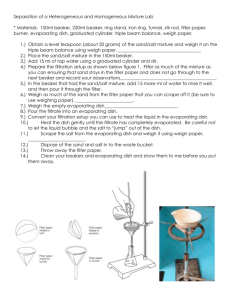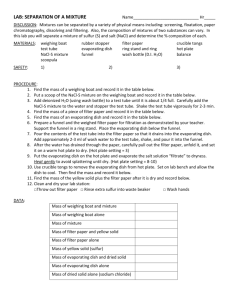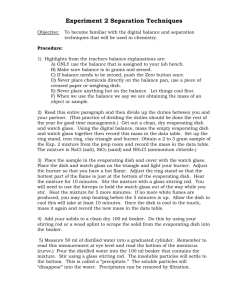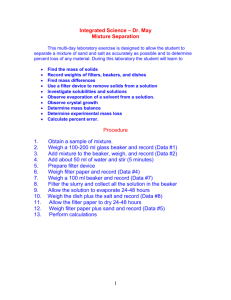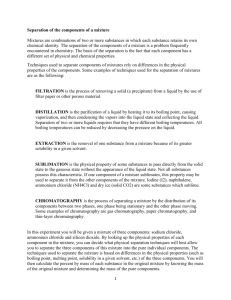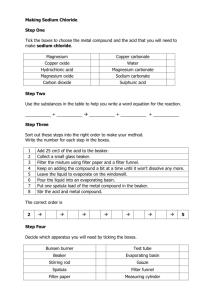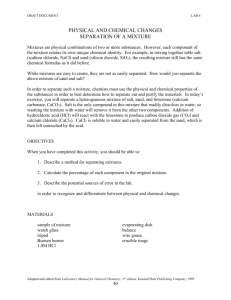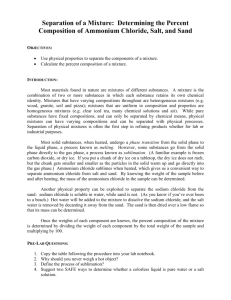Quantitative Separation of a Mixture Lab
advertisement
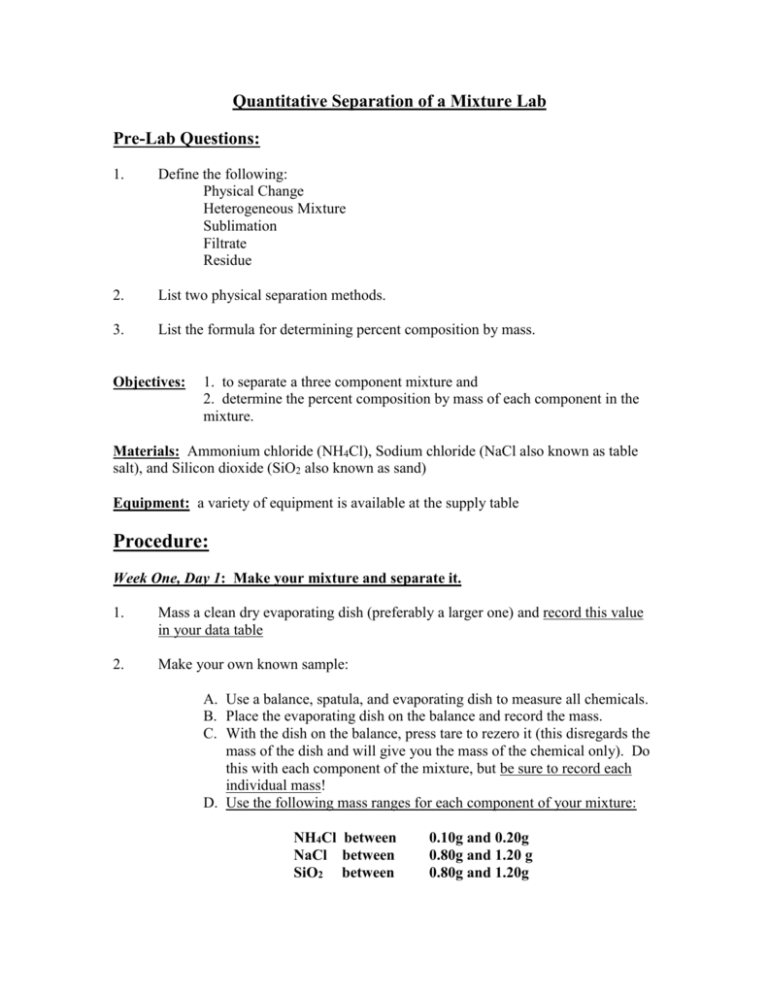
Quantitative Separation of a Mixture Lab Pre-Lab Questions: 1. Define the following: Physical Change Heterogeneous Mixture Sublimation Filtrate Residue 2. List two physical separation methods. 3. List the formula for determining percent composition by mass. Objectives: 1. to separate a three component mixture and 2. determine the percent composition by mass of each component in the mixture. Materials: Ammonium chloride (NH4Cl), Sodium chloride (NaCl also known as table salt), and Silicon dioxide (SiO2 also known as sand) Equipment: a variety of equipment is available at the supply table Procedure: Week One, Day 1: Make your mixture and separate it. 1. Mass a clean dry evaporating dish (preferably a larger one) and record this value in your data table 2. Make your own known sample: A. Use a balance, spatula, and evaporating dish to measure all chemicals. B. Place the evaporating dish on the balance and record the mass. C. With the dish on the balance, press tare to rezero it (this disregards the mass of the dish and will give you the mass of the chemical only). Do this with each component of the mixture, but be sure to record each individual mass! D. Use the following mass ranges for each component of your mixture: NH4Cl between NaCl between SiO2 between 0.10g and 0.20g 0.80g and 1.20 g 0.80g and 1.20g 3. Place the dish on a hot plate and heat to sublime the NH4Cl. If possible, due this in a fume hood. 4. During the heating process gently stir the sample in order to facilitate the sublimation – white smoking. You will see the NH4Cl deposing on the stirring rod. This is fine because you will figure out the mass of NH4Cl by subtraction. 5. When the smoking has completely ceased, heat for two more minutes. CAREFULLY transfer the dish using crucible tongs to a wire gauze to cool. 6. Allow the sample to cool for at least 3 minutes and then mass the dish and remaining sample and record. 7. Label a piece of filter paper with your name and class period in pencil. Fold the paper, mass, and record. 8. Add about 40 mL of deionized water to the evaporating dish. 9. Using a CLEAN stirring rod, stir the sample until you have dissolved as much as possible (the sand will remain undissolved) 10. Label a CLEAN beaker with your name and class period using tape. Mass the beaker AFTER YOU LABEL IT and record. 11. Set up the filtering apparatus with the massed beaker from step 10 under the funnel to collect the filtrate 12. Place the massed filter paper in the funnel and moisten it with deionized water to keep it in place. 13. Slowly pour the mixture from your evaporating dish into the funnel to filter. 14. After all the mixture has been rinsed from the dish (rinse the back by holding it over the funnel and squirting the back of the dish with your wash bottle); rinse the residue in the filter paper with approximately 10mL more of deionized water from your wash bottle. 15. CARFEULLY place the labeled beaker and the labeled filter paper (carefully unfolded on a watch glass) on the tray to dry under the heat lamp overnight Week 1, Day 2: Mass dry components 16. 17. 18. 19. Mass the dry filter paper and record. Mass the dry beaker and record. Place the filter paper containing sand in the trash can. Wash the salt out of the beaker and return it to the equipment lab bench. Week Two, Day 1: Same as week 1, but with an unknown sample - remember you are being graded for accuracy (you may have one, two or all three of the components in your mixture). 1. Mass a clean dry large evaporating dish and record. 2. Pour your sample into the dish. Make sure the ENTIRE sample is transferred to the dish. 3. Mass your dish and sample and record the mass and sample number. 4. Analyze the sample as you did in week 1 (steps 3 – 15). Week Two, Day 2: 1. 2. 3. 4. Mass the dry filter paper and record. Mass the dry beaker and record. Place the filter paper containing sand in the trash can. Wash the salt out of the beaker and return it to the equipment lab bench. Post-Lab Questions: 1. Why was it important to make sure the entire sample was transferred in step 2 of week 2, day 1? 2. What physical properties of NH4Cl, NaCl, and SiO2 made it possible for you to separate them in this lab? 3. Would this type of separation work to separate a compound into its elements? Explain. 4. Which separation method do you believe resulted in the most experimental error and WHY? 5. Discuss one change you would make to the procedure that you believe would decrease the overall amount of experimental error? For Your Report: The entire lab answer packet: 1. Answers to pre-lab questions 2. Data tables 3. Calculations for both weeks (SHOWING ALL WORK FOR EACH – FINAL ANSWERS ONLY WILL RECEIVE MAJOR DEDUCTIONS) 4. Answers to post-lab questions 5. Conclusion (as directed by your teacher)
